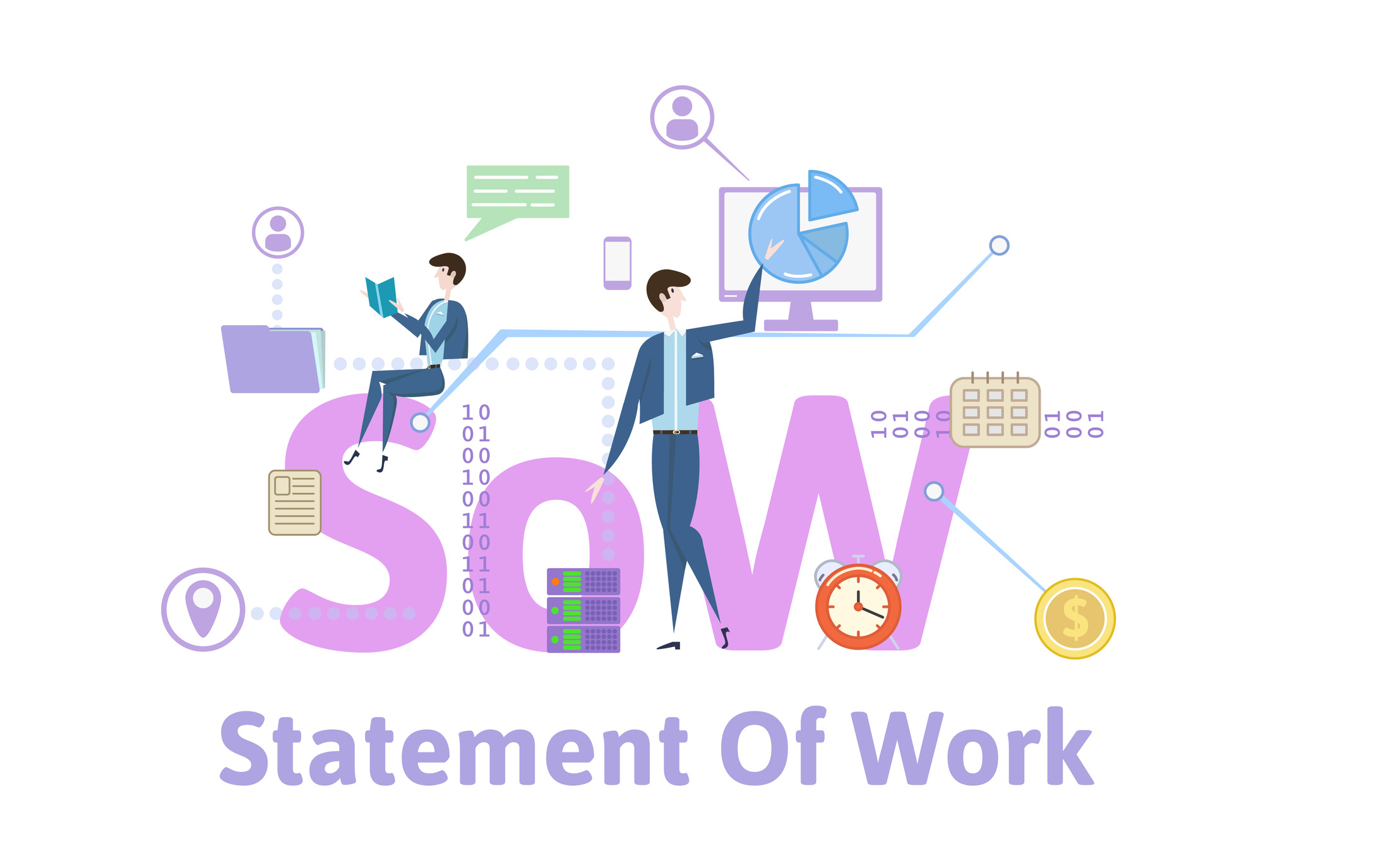Maximize Efficiency with Flexible Staffing Solutions Using SOW
Flexible staffing solutions using Statements of Work (SOW) are revolutionizing the staffing industry by offering unmatched efficiency and...

Unlock the potential of your staffing strategy by understanding the intricacies of Statement of Work (SOW) in staffing.
A staffing SOW (Statement of Work) is a comprehensive and formal document that meticulously outlines the scope, objectives, and deliverables of a particular project. It serves as a crucial framework that guides all project-related activities, ensuring that there is a shared understanding of what the project aims to achieve and the specific outcomes that are expected. SOW's can exist on their own or be integrated with a software program such as a VMS. In the context of staffing, an SOW plays a vital role by clearly defining the roles, responsibilities, and expectations for the MSP, the client and the staffing agencies involved. This ensures that all parties are aligned in terms of what is required, who is responsible for what tasks, and what the overall expectations are regarding the project’s completion.
Furthermore, the SOW functions as a binding contractual agreement that guarantees all parties involved are on the same page concerning the project requirements, timelines, and anticipated outcomes. This agreement lays a solid foundation for collaboration by providing a structured approach to handle all aspects of the project, from initiation to completion. By providing this level of clarity and detail, the SOW helps to significantly minimize misunderstandings and potential conflicts that could arise during the course of the project. Additionally, it enhances the efficiency of the staffing process by ensuring all stakeholders have a mutual understanding of their roles, the work to be performed, and the timelines to be adhered to, ultimately facilitating smoother project execution and successful achievement of the set objectives.
An effective Statement of Work (SOW) in staffing should encompass a range of key components to ensure it adequately fulfils the requirements and expectations of both the client, the MSP and the staffing agency. These essential components typically include:
Project Overview: This section provides a concise yet comprehensive description of the project, outlining its primary purpose and objectives. It establishes the groundwork for the entire staffing process by offering a clear vision of what the project aims to achieve and why it is important.
Scope of Work: This component delves into the specifics by offering detailed information about the various tasks, activities, and responsibilities that are integral to the project. It outlines the exact nature of the work that needs to be performed, ensuring that both the client and the staffing agency have a mutual understanding of the project's demands.
Deliverables: Here, the SOW specifies the particular outcomes or products that the staffing agency is expected to deliver upon project completion. It defines what constitutes a successful delivery, providing a clear benchmark for evaluating the project's progress and success.
Timeline: This section establishes a comprehensive schedule that outlines the project's start and end dates, along with key milestones and deadlines. It ensures that all parties are aligned on the time-frame for completing tasks, allowing for efficient planning and resource allocation.
Performance Standards: The SOW sets forth criteria for evaluating the quality and success of the work performed. By defining these standards, it ensures that the project maintains a high level of quality and that any deviations from expected outcomes can be promptly addressed.
Payment Terms: This component details the compensation structure, including the rates, payment schedules, and any additional expenses that may be incurred during the project's execution. It provides clarity on financial arrangements, ensuring that both parties have a clear understanding of payment expectations and timelines.
Using an SOW in staffing offers numerous benefits that can significantly enhance the effectiveness of your staffing strategy by providing a structured and detailed approach to project management. Some of the key benefits include:
Clear Expectations: An SOW provides a clear and detailed outline of what is expected from both the MSP, staffing agency and the client, specifying every aspect of the project requirements and deliverables. This comprehensive documentation ensures that all parties involved have a mutual understanding of the objectives, tasks, and outcomes, which greatly reduces the likelihood of misunderstandings or misinterpretations that could potentially derail the project.
Enhanced Accountability: With defined roles and responsibilities explicitly stated within the SOW, all parties involved, including team members, staffing agencies, and clients, are held accountable for their specific contributions to the project. This clarity in accountability encourages individuals to take ownership of their tasks, fostering a sense of responsibility and commitment to meeting the project goals and delivering high-quality results.
Improved Efficiency: By outlining the project scope, activities, and timelines in a detailed manner, an SOW helps in streamlining the staffing process. This structured approach allows for more efficient use of resources, as it enables better planning and allocation of tasks according to the available skills and time-frames. As a result, it minimizes wasted efforts and optimizes productivity, leading to a smoother execution of the project.
Risk Mitigation: An SOW plays a critical role in identifying potential risks and establishing proactive measures to mitigate them. By detailing the project's scope and anticipated challenges, it allows for thorough risk assessment and the development of contingency plans. This foresight ensures that any unforeseen issues can be addressed promptly, keeping the project on track and minimizing disruptions. Additionally, having a clear framework for risk management enhances the overall resilience of the project, enabling teams to adapt and respond effectively to any emerging threats.
While SOWs offer numerous benefits, they also present a unique set of challenges that can impact the success of a project if not properly managed. These challenges can be multifaceted and require careful consideration and strategic planning to address effectively. Some common challenges include:
Scope Creep: One of the most prevalent challenges is scope creep, which occurs when the project's scope expands beyond its original objectives. This can lead to additional work, increased costs, and extended timelines, often resulting in strained resources and budget overruns. To mitigate this issue, it is crucial to clearly define the project's scope from the outset and establish a robust process for managing any changes. This involves setting up formal change management procedures that require approval from relevant stakeholders before any modifications are made. Regular reviews and updates of the project scope can also help in maintaining focus and ensuring that the project remains on track.
Miscommunication: Effective communication is vital to the success of any project. However, inadequate communication can lead to misunderstandings, confusion, and errors, potentially derailing the project. To address this challenge, it is essential to establish regular communication channels and provide consistent updates to all parties involved. This can be achieved through scheduled meetings, progress reports, and open lines of communication that encourage feedback and collaboration. By fostering a culture of transparent communication, teams can ensure that everyone is aligned with the project's goals and objectives.
Unrealistic Timelines: Setting unrealistic timelines is another common challenge that can lead to rushed work, reduced quality, and increased stress among team members. To prevent this, it is important to ensure that project timelines are realistic and achievable, taking into account the complexity of tasks and the availability of resources. This involves conducting thorough planning and analysis to accurately estimate the time required for each phase of the project. Additionally, incorporating buffer time for unforeseen delays can help in maintaining quality without compromising deadlines.
Compliance Issues: Navigating compliance with legal and regulatory requirements can be a complex and daunting task. Failure to comply can result in legal repercussions and damage to the organization's reputation. To overcome this challenge, it is essential to regularly review and update the SOW to ensure it aligns with current laws and regulations. This involves consulting with legal experts and staying informed about any changes in the regulatory landscape. By proactively managing compliance, organizations can minimize risks and ensure the project's integrity.
Implementing an SOW effectively requires adherence to a set of well-defined best practices that can significantly enhance its utility and effectiveness, ultimately maximizing the benefits it offers to the organization. Here are some comprehensive best practices to consider:
Involve Key Stakeholders: It is crucial to engage all relevant stakeholders in the creation of the SOW from the very beginning. This includes project managers, team leaders, clients, and any other individuals or groups who have a vested interest in the project's success. By involving these key players early on, you can gather diverse insights and perspectives that ensure the SOW comprehensively addresses all necessary aspects of the project. This collaborative approach fosters a sense of ownership and alignment among stakeholders, increasing their commitment to the project's goals.
Be Specific and Detailed: When drafting the SOW, it is imperative to provide as much detail as possible. This includes specifying the scope of work, defining roles and responsibilities, outlining deliverables, setting timelines, and establishing performance standards. Detailed documentation helps to avoid ambiguities and misunderstandings, ensuring that everyone involved has a clear understanding of their roles and responsibilities. The more precise the SOW, the less room there is for interpretation, which reduces the risk of miscommunication and errors during project execution.
Review and Revise: Regularly reviewing the SOW is a vital practice to ensure it remains relevant and up-to-date throughout the project life-cycle. This involves assessing the SOW at key milestones or whenever significant changes occur in the project scope or requirements. By making necessary revisions and updates, you can address any emerging issues or changes in the project environment. This proactive approach helps in maintaining alignment with the project's evolving needs, minimizing disruptions, and ensuring that all stakeholders remain informed and engaged.
Monitor and Evaluate: Continuously monitoring the progress of the project against the SOW is essential for maintaining control and oversight. This involves tracking the completion of tasks, assessing adherence to timelines, and evaluating performance against established standards. Regular evaluation allows project managers to ensure compliance with the SOW and identify areas for improvement. By maintaining a vigilant approach to monitoring, you can quickly detect deviations from the plan and implement corrective actions, thereby enhancing the likelihood of successful project outcomes.

Flexible staffing solutions using Statements of Work (SOW) are revolutionizing the staffing industry by offering unmatched efficiency and...

Discover how the Statement of Work (SOW) can revolutionize your staffing strategy, enhance profitability, and uncover substantial project...

Explore how mid-market SOW software can transform project management for staffing agencies and MSPs, driving efficiency, profitability, and growth.